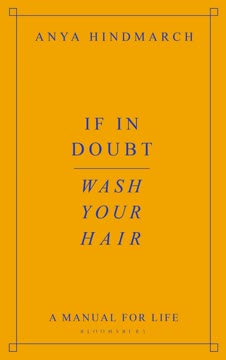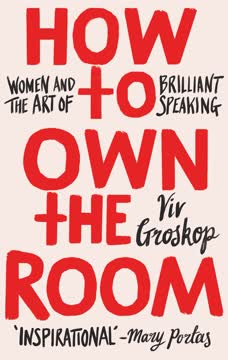Key Takeaways
1. Owning the Room: Presence Over Perfection
To be the speaker you want to be is much more important than the actual speech.
Focus on the speaker, not the speech. Many public speaking guides focus on content, but the most significant barrier for many, especially women, is the anxiety surrounding public speaking itself. It's more important to cultivate the mindset and persona of a confident speaker than to obsess over the perfect script.
Form matters more than content. Studies suggest that non-verbal communication accounts for a significant portion of how a message is received. Mastering body language, tone of voice, and overall presence can be more impactful than the words themselves.
Embrace imperfection. The pursuit of a flawless speech can be paralyzing. Instead, focus on being a credible, honest version of yourself. Authenticity resonates more with audiences than manufactured perfection.
2. Embrace Your Authentic Voice
Women don’t need to find a voice. They have a voice. They need to feel empowered to use it and people need to be encouraged to listen.
Focus on behavior, not culture. While structural inequalities exist, focus on honing your own speaking skills rather than dwelling on external barriers. This proactive approach empowers you to amplify your voice regardless of the surrounding culture.
Create your own opportunities. Don't wait to be chosen. With modern technology, it's easier than ever to create your own platforms through vlogs, podcasts, and social media.
Status quo is a numbers problem. Acknowledge that there are fewer women in senior roles, but focus on creating your own opportunities and feeling great about your ability to communicate. As Oprah says, "There is no discrimination against excellence."
3. Happy High Status: Radiate Confidence
Happy high status is the single most important thing about being a strong public speaker.
Happy high status is key. This concept embodies comfort, grace, and charm, even in unexpected situations. It's about being secure in yourself and your value, regardless of external circumstances.
Status is a state of mind. Happy high status isn't tied to a position or title. A toilet attendant can embody it just as much as a CEO. It's about how you feel inside and how you project that to the world.
Acquire, practice, and improve. Happy high status can be cultivated through self-awareness and conscious effort. It involves being interested in others, not taking things personally, and making everything seem easy and natural.
4. The Power of Pace and Pauses
The more complex your ideas, the slower your speech.
Slow down for clarity. Most speakers tend to talk too fast, especially when nervous. Deliberately slowing down allows the audience to process information and demonstrates confidence.
Pauses are powerful. Strategic pauses give the audience time to absorb your message and create a sense of anticipation. Voice coach Caroline Goyder suggests that those who pause naturally, 3.5 times per minute, are the most successful at influencing their audience.
Context matters. While slowing down is generally beneficial, pace is subjective. Adapt your speed to the audience and the complexity of the material. If your strength is fluency, harness it during dynamic parts of your speech and slow down for crucial points.
5. Conviction: Speak From the Heart
There is no discrimination against excellence.
Conviction is key. Projecting a solid, definite idea is crucial for capturing and maintaining attention. This requires extreme focus, strong eye contact, and a deep belief in your message.
Intimacy and risk. Share personal stories and vulnerabilities to connect with the audience on a deeper level. This demonstrates authenticity and makes your message more impactful.
Stillness amplifies conviction. Control your body movements to draw attention to your words. Stillness can create a sense of power and authority, allowing your message to resonate more deeply.
6. Defy Expectations: Be Unapologetically You
Comedy is subjective. Success is objective.
Authenticity over likeability. Don't be afraid to be yourself, even if it means defying conventional expectations. Joan Rivers, for example, achieved success by being brash, irreverent, and unapologetically herself.
Find your own style. Don't try to emulate someone else's persona. Discover what works for you and embrace your unique qualities, even if they're unconventional.
Work hard and "cheat" when necessary. Rivers used cue cards and a vast filing system to support her performances. Find systems that work for you, even if they seem unconventional.
7. Harness Vulnerability and Imperfection
We touch other people’s lives simply by existing.
Share your story. Audiences connect with speakers who are willing to share their personal experiences, struggles, and vulnerabilities. This creates a sense of authenticity and makes your message more relatable.
It's okay to be nervous. Acknowledge your nerves and imperfections. This makes you more human and approachable. As J.K. Rowling demonstrates, it's possible to give a powerful speech even when you're visibly nervous.
Focus on the message. Ultimately, the most important thing is to deliver a message that resonates with the audience. Don't let the pursuit of perfection overshadow the value of your content.
8. Create Your Own Opportunities
Choose yourself.
Don't wait to be chosen. Actively seek out speaking opportunities. Propose yourself as a speaker, chairperson, or facilitator. Create your own platforms through vlogs, podcasts, and social media.
Tell people you want to speak. Let others know about your interest in public speaking. This can lead to unexpected opportunities and collaborations.
Practice in low-stakes environments. Gain experience by speaking in easy, comfortable settings. This will build your confidence and help you hone your skills.
9. Stillness and Deliberate Movement
The world needs you and it needs the things you carry.
Stillness commands attention. Veteran politicians like Angela Merkel and Hillary Clinton demonstrate the power of stillness. Holding your ground and silently commanding a room creates a powerful impression.
Deliberate movements. Use hand gestures and head movements sparingly to emphasize key points. This draws attention to your message and prevents distractions.
Neutrality can be powerful. Projecting a trustworthy neutrality can be effective, especially in politically sensitive situations. This approach conveys calm, focus, and a clear head.
10. The Importance of Preparation and Practice
What we achieve inwardly will change our outer reality.
Preparation is key. Even seemingly effortless speakers have often put in years of preparation and practice. Don't underestimate the value of honing your skills and mastering your material.
Practice, practice, practice. The more you speak, the more comfortable you'll become. Seek out opportunities to practice in different settings and with different audiences.
Seek feedback and refine your approach. Record yourself speaking and ask for constructive criticism. Use this feedback to identify areas for improvement and refine your style.
Last updated:
FAQ
What’s "How to Own the Room" by Viv Groskop about?
- Focus on Women’s Speaking Power: The book explores how women can develop presence, performance, and authenticity in public speaking, drawing on examples from history’s great women speakers.
- Practical and Inspirational: It combines practical advice, exercises, and real-life stories to help women overcome nerves and self-doubt and find their unique speaking style.
- Not Just About Content: Groskop emphasizes that owning the room is more about how you present yourself than the exact words you say.
- Diverse Role Models: The book analyzes speeches and styles from figures like Michelle Obama, Oprah Winfrey, Virginia Woolf, Joan Rivers, and Chimamanda Ngozi Adichie.
Why should I read "How to Own the Room" by Viv Groskop?
- Empowerment for Women: It’s specifically designed to help women feel empowered to use their voices and be heard, addressing the unique challenges they face.
- Actionable Techniques: The book is full of practical tips, tricks, and exercises that can be immediately applied to real-life speaking situations.
- Realistic and Relatable: Groskop acknowledges nerves and imperfection, making the advice accessible for beginners and experienced speakers alike.
- Broad Application: The lessons apply to everything from boardroom presentations to wedding toasts, not just formal speeches.
What are the key takeaways from "How to Own the Room"?
- Presence Over Perfection: Being present, authentic, and comfortable in your own skin is more important than delivering a flawless speech.
- Happy High Status: Cultivating an inner sense of confidence and ease—what Groskop calls “happy high status”—is crucial for commanding attention.
- Practice and Exposure: The only way to get better at speaking is to do it often, embracing nerves and learning from mistakes.
- Personal Style Matters: There’s no single “right” way to speak; finding and embracing your own style is key.
What is the concept of "happy high status" in Viv Groskop’s method?
- Inner Confidence: Happy high status is about feeling genuinely comfortable and confident in yourself, regardless of your position or audience.
- Grace Under Pressure: It’s the ability to handle any situation with charm and composure, even if things go wrong or you’re mistaken for someone else.
- Not About Arrogance: This status is not about being superior, but about being relaxed, open, and generous with your presence.
- Learnable Skill: While some people have it naturally, Groskop argues it can be developed through practice and self-awareness.
How does Viv Groskop suggest women overcome nerves and self-doubt in public speaking?
- Accept Nerves as Normal: Nerves are a universal part of public speaking—even for the most experienced speakers.
- Physical Techniques: Use grounding exercises like standing with feet hip-width apart, breathing deeply, and visualizing confidence.
- Challenge Limiting Beliefs: Identify and reframe negative self-talk and excuses that hold you back from speaking opportunities.
- Practice and Exposure: The more you speak, the more comfortable you become; “inoculation training” helps reduce anxiety over time.
What does Viv Groskop mean by "presence," and how can women develop it?
- Being Fully Present: Presence is about being engaged, focused, and comfortable in the moment, rather than distracted or self-conscious.
- Physical Cues: Open posture, strong eye contact, and stillness help project presence to an audience.
- Honesty and Vulnerability: Being authentic and honest about your feelings (even nerves) can make you more relatable and compelling.
- Practice Mindfulness: Techniques like meditation and visualization can help you access presence before and during a speech.
How does "How to Own the Room" address the importance of body language and non-verbal communication?
- Non-Verbal Dominance: Groskop cites research showing that 60-90% of communication is non-verbal, making body language crucial.
- Posture and Gestures: Standing tall, using open gestures, and maintaining stillness can enhance authority and audience engagement.
- Tone and Expression: The way you use your voice and facial expressions often matters more than the words themselves.
- Preparation Techniques: Power poses and breathing exercises can help align your body language with your intended message.
What are some practical exercises and tips from "How to Own the Room" for improving public speaking?
- Grounding and Breathing: Practice standing with shoulders back, feet planted, and breathing through the soles of your feet to calm nerves.
- Visualization: Recall moments when you felt proud or confident to access those feelings before speaking.
- Recording and Playback: Record yourself speaking to analyze pace, clarity, and presence, and adjust accordingly.
- Structured Practice: Write and deliver short speeches of varying lengths, experiment with jokes or personal stories, and seek feedback.
How does Viv Groskop use examples of famous women speakers in "How to Own the Room"?
- Diverse Role Models: The book analyzes the speaking styles of Michelle Obama, Oprah Winfrey, Virginia Woolf, Joan Rivers, J.K. Rowling, Chimamanda Ngozi Adichie, Angela Merkel, and others.
- Lessons from Each: Groskop extracts specific lessons from each woman—such as Michelle Obama’s happy high status, Oprah’s conviction, Woolf’s deliberate pace, and Adichie’s calm authority.
- Realistic Comparisons: She emphasizes that these women developed their skills over time and often had support teams, making their journeys relatable.
- Encouragement to Adapt: Readers are encouraged to draw inspiration but find their own authentic style rather than copying others.
What does "How to Own the Room" say about perfectionism and making mistakes in public speaking?
- Perfection Not Required: Groskop stresses that you don’t need to be perfect to be effective; authenticity and connection matter more.
- Embrace Mistakes: Mistakes, nerves, and even visible emotion can make you more relatable and likeable to your audience.
- Learn from Errors: Each speaking opportunity is a chance to improve; even great speakers like Michelle Obama and J.K. Rowling started out imperfectly.
- Lower the Stakes: Most speeches are not life-changing events; treat them as conversations rather than performances.
How does Viv Groskop address the challenges women face in public speaking and leadership?
- Acknowledges Gender Bias: The book discusses societal and cultural barriers that have historically limited women’s opportunities to speak and lead.
- Focus on Agency: Groskop encourages women to focus on what they can control—developing their own skills and seeking out opportunities.
- Representation Matters: She highlights the importance of seeing diverse women in leadership roles to inspire others.
- Creating Opportunities: Women are urged to “choose themselves,” create their own speaking chances, and support other women in doing the same.
What are the best quotes from "How to Own the Room" by Viv Groskop, and what do they mean?
- “Women don’t need to find a voice. They have a voice. They need to feel empowered to use it and people need to be encouraged to listen.” — Meghan Markle. This underscores the book’s central message: empowerment and being heard.
- “Happy high status is a state of mind as well as ease in your body.” This highlights the importance of internal confidence and physical presence.
- “You can’t get around fear. You can only go through it.” Groskop reminds readers that nerves are inevitable, but facing them is the only way to grow.
- “The world needs you and it needs the things you carry.” — Susan Cain, quoted in the book. This encourages women to share their unique perspectives and experiences.
- “Do whatever it takes to make it less intimidating for you.” Groskop advocates for making speaking opportunities as comfortable and enjoyable as possible, rather than treating them as ordeals.
Review Summary
How to Own the Room receives mostly positive reviews, with readers praising its practical advice, inspiring examples, and empowering approach to public speaking for women. Many appreciate the analysis of famous women speakers and their techniques. Some find it repetitive or overly focused on TED talks. Critics note occasional patronizing language. Overall, readers find it helpful for building confidence and improving speaking skills, though some feel it's best suited for those specifically interested in public speaking.
Similar Books





Download PDF
Download EPUB
.epub digital book format is ideal for reading ebooks on phones, tablets, and e-readers.






